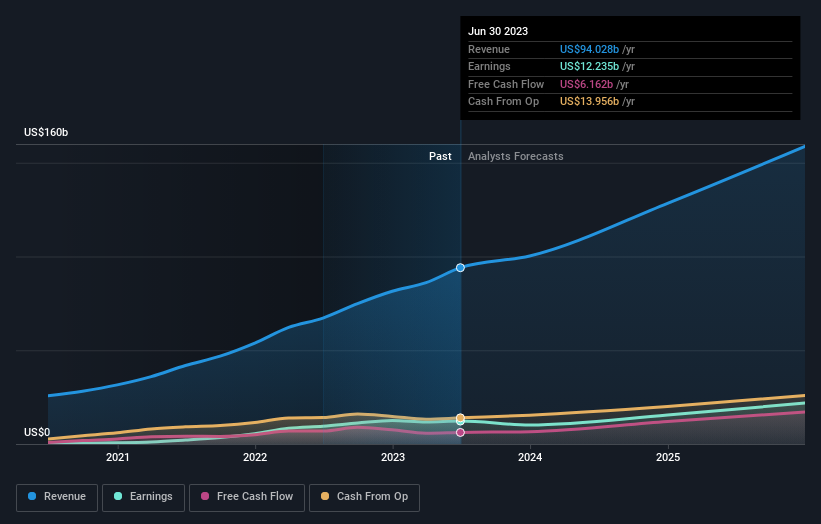After losing 10% in the past year, Tesla, Inc. (NASDAQ:TSLA) institutional owners must be relieved by the recent gain
Key Insights
Given the large stake in the stock by institutions, Tesla's stock price might be vulnerable to their trading decisions
A total of 25 investors have a majority stake in the company with 44% ownership
Every investor in Tesla, Inc. (NASDAQ:TSLA) should be aware of the most powerful shareholder groups. We can see that institutions own the lion's share in the company with 44% ownership. Put another way, the group faces the maximum upside potential (or downside risk).
Institutional investors would appreciate the 7.7% increase in share prices last week, given their one-year returns have been disappointing at 10%.
Let's take a closer look to see what the different types of shareholders can tell us about Tesla.
See our latest analysis for Tesla
What Does The Institutional Ownership Tell Us About Tesla?
Institutional investors commonly compare their own returns to the returns of a commonly followed index. So they generally do consider buying larger companies that are included in the relevant benchmark index.
We can see that Tesla does have institutional investors; and they hold a good portion of the company's stock. This can indicate that the company has a certain degree of credibility in the investment community. However, it is best to be wary of relying on the supposed validation that comes with institutional investors. They too, get it wrong sometimes. When multiple institutions own a stock, there's always a risk that they are in a 'crowded trade'. When such a trade goes wrong, multiple parties may compete to sell stock fast. This risk is higher in a company without a history of growth. You can see Tesla's historic earnings and revenue below, but keep in mind there's always more to the story.
Hedge funds don't have many shares in Tesla. The company's CEO Elon Musk is the largest shareholder with 13% of shares outstanding. The Vanguard Group, Inc. is the second largest shareholder owning 7.0% of common stock, and BlackRock, Inc. holds about 5.9% of the company stock.
On studying our ownership data, we found that 25 of the top shareholders collectively own less than 50% of the share register, implying that no single individual has a majority interest.
While it makes sense to study institutional ownership data for a company, it also makes sense to study analyst sentiments to know which way the wind is blowing. There are plenty of analysts covering the stock, so it might be worth seeing what they are forecasting, too.
Insider Ownership Of Tesla
While the precise definition of an insider can be subjective, almost everyone considers board members to be insiders. Company management run the business, but the CEO will answer to the board, even if he or she is a member of it.
I generally consider insider ownership to be a good thing. However, on some occasions it makes it more difficult for other shareholders to hold the board accountable for decisions.
Our most recent data indicates that insiders own a reasonable proportion of Tesla, Inc.. It has a market capitalization of just US$861b, and insiders have US$125b worth of shares in their own names. That's quite significant. Most would be pleased to see the board is investing alongside them. You may wish to access this free chart showing recent trading by insiders.
General Public Ownership
The general public-- including retail investors -- own 42% stake in the company, and hence can't easily be ignored. While this group can't necessarily call the shots, it can certainly have a real influence on how the company is run.
Next Steps:
It's always worth thinking about the different groups who own shares in a company. But to understand Tesla better, we need to consider many other factors. Consider for instance, the ever-present spectre of investment risk. We've identified 1 warning sign with Tesla , and understanding them should be part of your investment process.
Ultimately the future is most important. You can access this free report on analyst forecasts for the company.
NB: Figures in this article are calculated using data from the last twelve months, which refer to the 12-month period ending on the last date of the month the financial statement is dated. This may not be consistent with full year annual report figures.
Have feedback on this article? Concerned about the content? Get in touch with us directly. Alternatively, email editorial-team (at) simplywallst.com.
This article by Simply Wall St is general in nature. We provide commentary based on historical data and analyst forecasts only using an unbiased methodology and our articles are not intended to be financial advice. It does not constitute a recommendation to buy or sell any stock, and does not take account of your objectives, or your financial situation. We aim to bring you long-term focused analysis driven by fundamental data. Note that our analysis may not factor in the latest price-sensitive company announcements or qualitative material. Simply Wall St has no position in any stocks mentioned.

 Yahoo News
Yahoo News 


